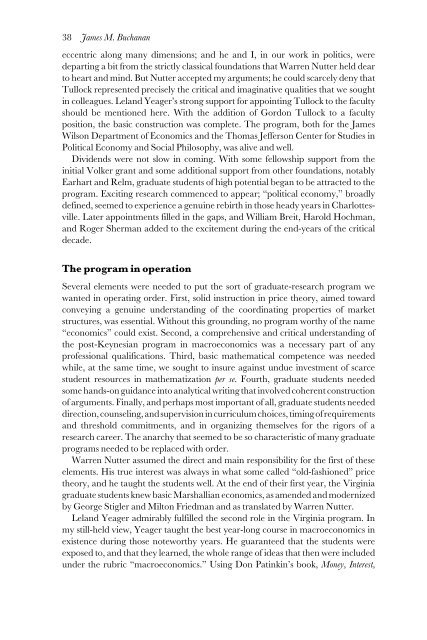Money and Markets: Essays in Honor of Leland B. Yeager
Money and Markets: Essays in Honor of Leland B. Yeager
Money and Markets: Essays in Honor of Leland B. Yeager
Create successful ePaper yourself
Turn your PDF publications into a flip-book with our unique Google optimized e-Paper software.
38 James M. Buchananeccentric along many dimensions; <strong>and</strong> he <strong>and</strong> I, <strong>in</strong> our work <strong>in</strong> politics, weredepart<strong>in</strong>g a bit from the strictly classical foundations that Warren Nutter held dearto heart <strong>and</strong> m<strong>in</strong>d. But Nutter accepted my arguments; he could scarcely deny thatTullock represented precisely the critical <strong>and</strong> imag<strong>in</strong>ative qualities that we sought<strong>in</strong> colleagues. Lel<strong>and</strong> <strong>Yeager</strong>’s strong support for appo<strong>in</strong>t<strong>in</strong>g Tullock to the facultyshould be mentioned here. With the addition <strong>of</strong> Gordon Tullock to a facultyposition, the basic construction was complete. The program, both for the JamesWilson Department <strong>of</strong> Economics <strong>and</strong> the Thomas Jefferson Center for Studies <strong>in</strong>Political Economy <strong>and</strong> Social Philosophy, was alive <strong>and</strong> well.Dividends were not slow <strong>in</strong> com<strong>in</strong>g. With some fellowship support from the<strong>in</strong>itial Volker grant <strong>and</strong> some additional support from other foundations, notablyEarhart <strong>and</strong> Relm, graduate students <strong>of</strong> high potential began to be attracted to theprogram. Excit<strong>in</strong>g research commenced to appear; “political economy,” broadlydef<strong>in</strong>ed, seemed to experience a genu<strong>in</strong>e rebirth <strong>in</strong> those heady years <strong>in</strong> Charlottesville.Later appo<strong>in</strong>tments filled <strong>in</strong> the gaps, <strong>and</strong> William Breit, Harold Hochman,<strong>and</strong> Roger Sherman added to the excitement dur<strong>in</strong>g the end-years <strong>of</strong> the criticaldecade.The program <strong>in</strong> operationSeveral elements were needed to put the sort <strong>of</strong> graduate-research program wewanted <strong>in</strong> operat<strong>in</strong>g order. First, solid <strong>in</strong>struction <strong>in</strong> price theory, aimed towardconvey<strong>in</strong>g a genu<strong>in</strong>e underst<strong>and</strong><strong>in</strong>g <strong>of</strong> the coord<strong>in</strong>at<strong>in</strong>g properties <strong>of</strong> marketstructures, was essential. Without this ground<strong>in</strong>g, no program worthy <strong>of</strong> the name“economics” could exist. Second, a comprehensive <strong>and</strong> critical underst<strong>and</strong><strong>in</strong>g <strong>of</strong>the post-Keynesian program <strong>in</strong> macroeconomics was a necessary part <strong>of</strong> anypr<strong>of</strong>essional qualifications. Third, basic mathematical competence was neededwhile, at the same time, we sought to <strong>in</strong>sure aga<strong>in</strong>st undue <strong>in</strong>vestment <strong>of</strong> scarcestudent resources <strong>in</strong> mathematization per se. Fourth, graduate students neededsome h<strong>and</strong>s-on guidance <strong>in</strong>to analytical writ<strong>in</strong>g that <strong>in</strong>volved coherent construction<strong>of</strong> arguments. F<strong>in</strong>ally, <strong>and</strong> perhaps most important <strong>of</strong> all, graduate students neededdirection, counsel<strong>in</strong>g, <strong>and</strong> supervision <strong>in</strong> curriculum choices, tim<strong>in</strong>g <strong>of</strong> requirements<strong>and</strong> threshold commitments, <strong>and</strong> <strong>in</strong> organiz<strong>in</strong>g themselves for the rigors <strong>of</strong> aresearch career. The anarchy that seemed to be so characteristic <strong>of</strong> many graduateprograms needed to be replaced with order.Warren Nutter assumed the direct <strong>and</strong> ma<strong>in</strong> responsibility for the first <strong>of</strong> theseelements. His true <strong>in</strong>terest was always <strong>in</strong> what some called “old-fashioned” pricetheory, <strong>and</strong> he taught the students well. At the end <strong>of</strong> their first year, the Virg<strong>in</strong>iagraduate students knew basic Marshallian economics, as amended <strong>and</strong> modernizedby George Stigler <strong>and</strong> Milton Friedman <strong>and</strong> as translated by Warren Nutter.Lel<strong>and</strong> <strong>Yeager</strong> admirably fulfilled the second role <strong>in</strong> the Virg<strong>in</strong>ia program. Inmy still-held view, <strong>Yeager</strong> taught the best year-long course <strong>in</strong> macroeconomics <strong>in</strong>existence dur<strong>in</strong>g those noteworthy years. He guaranteed that the students wereexposed to, <strong>and</strong> that they learned, the whole range <strong>of</strong> ideas that then were <strong>in</strong>cludedunder the rubric “macroeconomics.” Us<strong>in</strong>g Don Pat<strong>in</strong>k<strong>in</strong>’s book, <strong>Money</strong>, Interest,
















